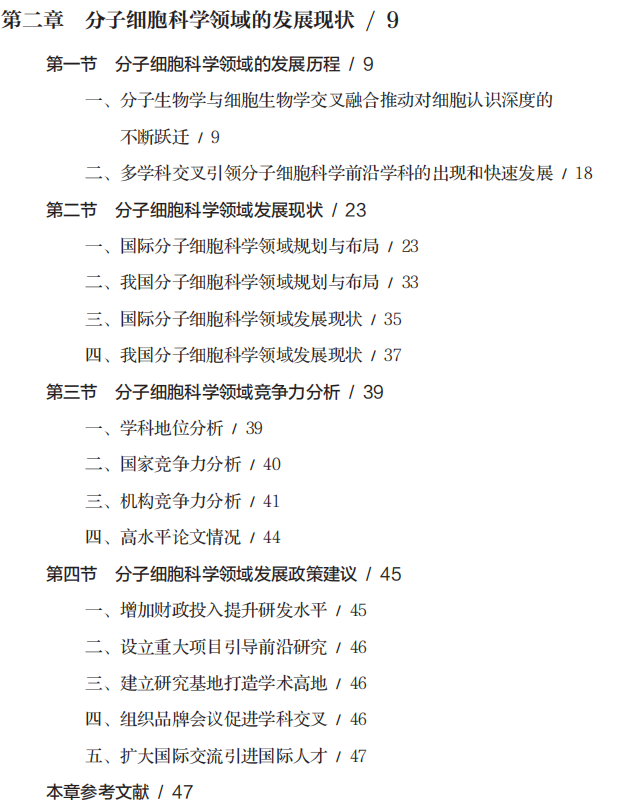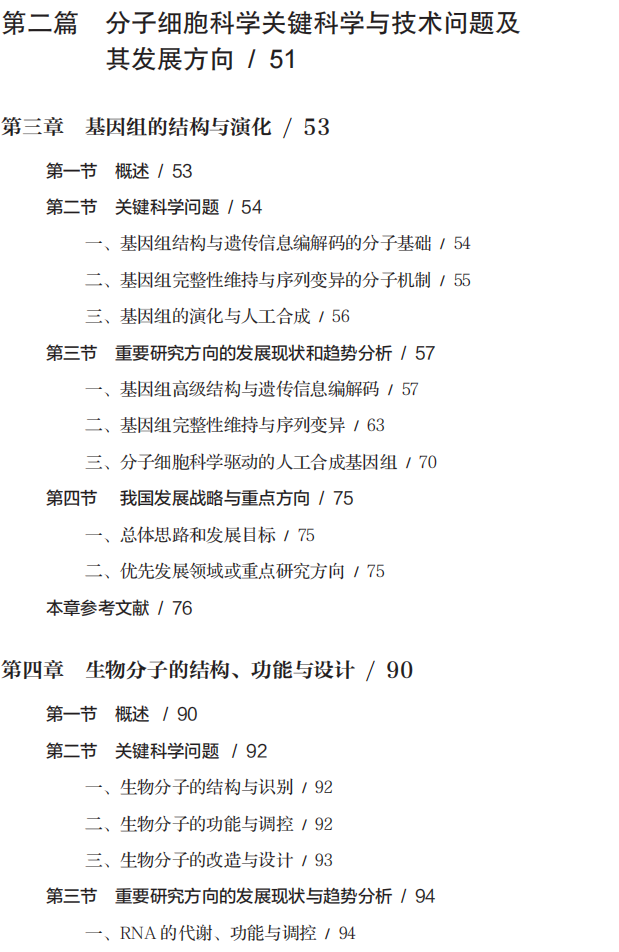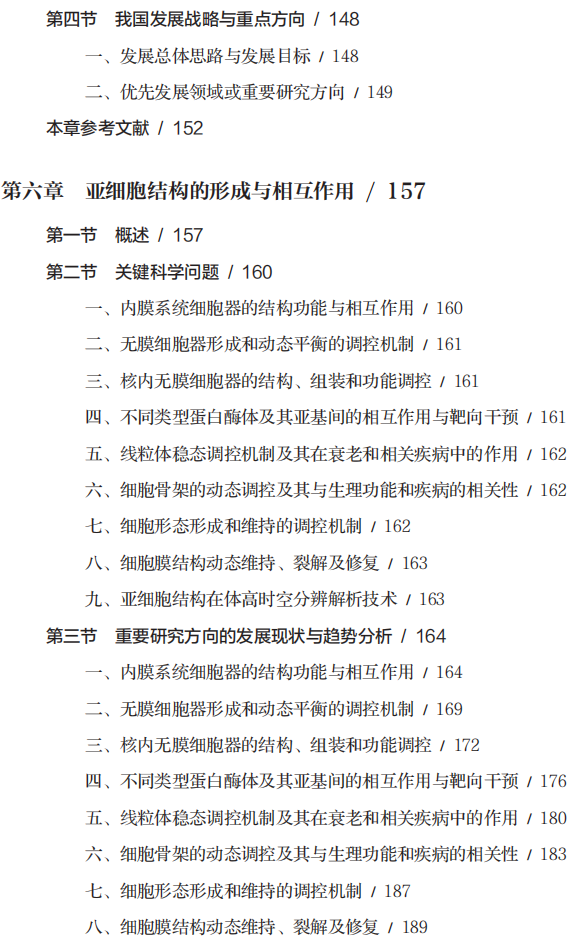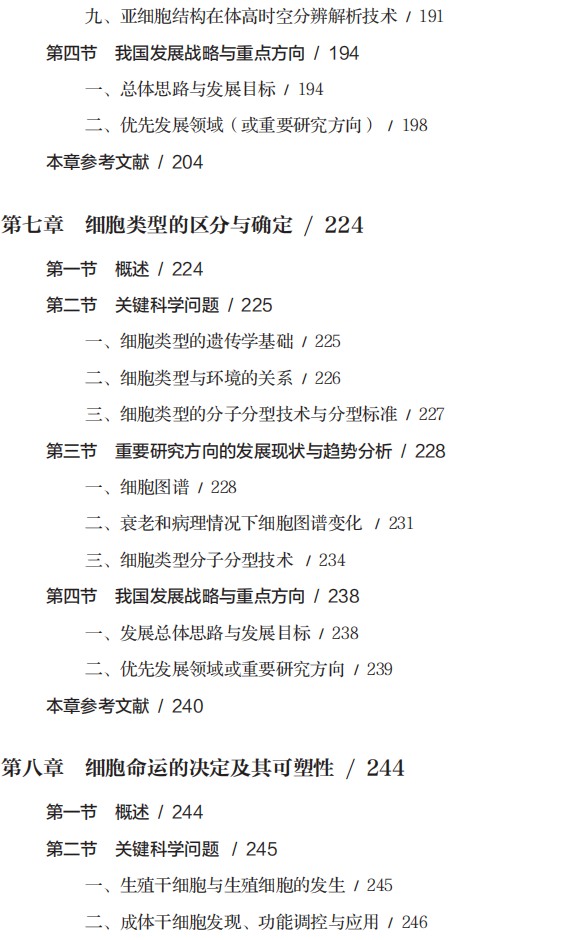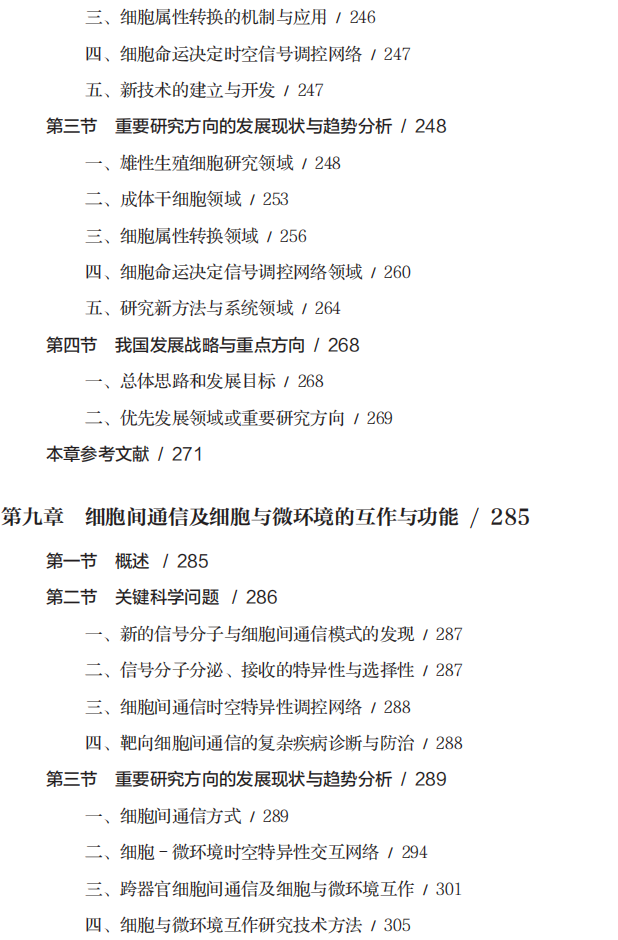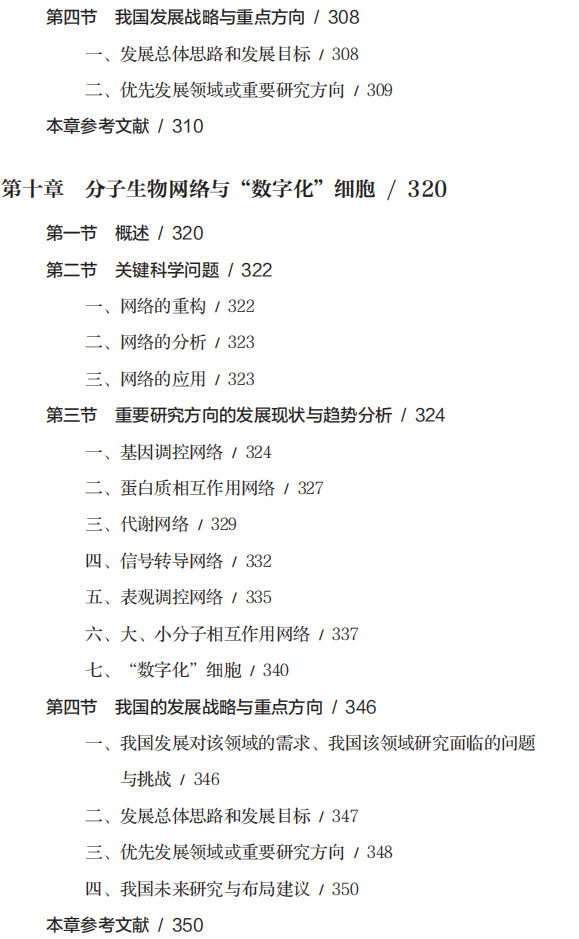细胞是生命体结构和功能的基本单位。生物的生长、发育、繁殖与进化等一切生命活动都以细胞为基础。多细胞生物包含多种形态与功能各异的细胞,所有这些细胞都是由单个的受精卵分裂、增殖、分化而来的。为什么受精卵可以产生所有类型的细胞?为什么在生命个体发育过程中细胞的形态和功能会发生转变?为什么某种组织的细胞(如神经细胞、肌肉细胞)一旦形成就会稳定维持它的特性?为什么有机体的正常细胞会转变为不正常的癌细胞或其他病变细胞?关于细胞的这些待解之谜是当代生命科学基础研究的热点前沿。作为生命的基础,细胞里包含众多种类的分子,如核酸、蛋白质、糖类和脂类等,这些生物分子相互作用,组装成结构与功能不一的复合体机器或亚细胞结构,并在细胞的基本生命活动过程中展现了纷繁复杂的各种生命现象。绘制细胞基本生命活动的分子调控图谱是生命科学研究的终极目标之一,而要真正实现这一目标,除了运用传统的分子生物学和细胞生物学研究方法,还需要进行多学科交叉,借助和发展不同于经典实验生命科学的新技术和新方法,系统地研究细胞的生命本质与活动规律。
分子细胞科学是以分子生物学和细胞生物学为基础,与数学、物理、化学、信息科学、医学等交叉融合,研究细胞生命活动规律及其分子机制的前沿性、交叉性新兴学科。利用学科交叉新技术、新手段,对生物分子、功能元件和细胞进行定性到定量、延滞到实时、静态到动态、离体到原位、单一到网络、局部到整体的研究,揭示其数量、形态、结构和功能的因果关系,为实现对细胞的操控与人工改造提供理论基础和技术手段。
发展分子细胞科学具有极大的科学意义与战略价值。在推动基础科学发展方面,分子细胞科学的发展将助力提高探索生命本质的深度,使对细胞结构和功能的探索实现从“对分子机制的单一表象分析”到“从多个维度深度阐释机理”的转变;同时为生命的改造提供更加优化的技术策略,进一步推动对细胞内分子表达和细胞功能的精准操控;此外,分子细胞科学的发展还为破解生命科学各学科中的重大科学问题提供更全面、更深入的支撑,将推进生命科学领域各学科的快速发展。在推动医药健康、农业和工业领域发展方面,分子细胞科学也具有重要的战略价值。第一,分子细胞科学将推动实现更精细、更真实地揭示人体生长发育和疾病发生发展机制和规律,可为疾病精准诊断和先进治疗的研发应用提供源头理论和创新策略。第二,分子细胞科学将进一步推动生物育种技术的优化和升级,推进高效、精准农业育种,同时也将为绿色农药创制和“细胞农业”产品开发等前沿方向的发展带来巨大的机遇。第三,分子细胞科学的发展还将为工业产品的绿色生物合成奠定理论和技术基础,助力设计构建酶分子、细胞和多细胞体系,优化调控代谢通路,最终实现对合成过程的人工控制。
分子细胞科学的发展主要经历了两个阶段。其一,分子生物学与细胞生物学交叉融合推动对细胞认识深度的不断跃迁:在传统细胞生物学的基础上,随着以基因组学为代表的组学研究技术促进细胞生命活动规律的全面解析、细胞工程技术的出现使细胞改造成为现实,遗传信息表达和调控、细胞物质运输、细胞信号转导、细胞命运调控等领域的研究逐渐勃兴,细胞生物学开始向分子细胞生物学的方向发展。其二,多学科交叉引领分子细胞科学前沿学科的出现及快速发展:单细胞、单分子技术,分子原位分析技术,成像技术,分子影像学,活细胞成像技术,多组学技术的出现和迭代进步使得这一时期的研究从平均化研究迈向单细胞、单分子差异化研究,从离体研究迈向携带空间信息的原位研究,从生物大分子的静态结构研究向动态分子电影制作发展,从断层式的分子细胞研究迈向无创、实时的观测,从单一分子的研究尺度向多层网络的整合分析发展,推动分子细胞生物学迈入分子细胞科学新阶段。
分子细胞科学作为生命科学的前沿领域,是全球科研的热点。在科研资助布局方面,美国国家科学基金会、英国医学研究理事会等国家科研资助机构均设置了专门的部门管理对分子细胞领域的资助,重点资助生物学与物理、化学、数学、计算科学等多学科交叉,增进对分子细胞基本功能、分子调控网络及机制的全面认识,并进一步将相关认识与生理学、病理学、医学相结合,以加深对疾病发生与治疗过程中应答机制的理解,进而推进药物靶标的发现和验证,以及新疗法的开发。美国国立卫生研究院也非常重视分子细胞科学相关基础研究,资助了4D细胞核组(4D Nucleome)计划和人类生物分子图谱计划(Human Biomolecular Atlas Program,HuBMAP)等专项计划,旨在推进活细胞追踪技术、单细胞测序技术、成像技术等研究单细胞活动的技术的发展,并在此基础上探究分子细胞特征及其相关变化对发育和各类疾病的影响。此外,美国、日本、欧盟等科技发达国家/组织相继出台了分子细胞科学领域的专项发展规划,包括全球大型国际合作项目人类细胞图谱(Human Cell Atlas,HCA)计划、日本活细胞图谱战略建议、日本4D细胞组战略建议、欧盟新“FET旗舰计划”的筹备行动——疾病发生发展机制研究(LifeTime)等。我国主要通过国家自然科学基金、国家重点研发计划、中国科学院战略性先导科技专项等对分子细胞科学领域进行资助。在科研论文产出方面,通过对作为分子细胞科学基础和重要组成部分的分子细胞生物学进行定量分析发现,1980~2020 年全球共发表研究论文680 055篇,始终维持较快的发展速度。2011~2020年是我国分子细胞生物学研究领域快速发展阶段,论文数量从2011年的2441篇增长至2020年的12 560篇,年均增长率达到19.96%。这10年期间,我国共发表分子细胞生物学论文70 756篇,占该时间段全球发表的分子细胞生物学论文总量的24.93%,位居全球第2位;在全球分子细胞生物学论文数量排名前10位的国家中,我国论文的总被引频次居第2位,篇均被引频次居第10位。
本报告围绕分子细胞科学的9个方面(即:①基因组的结构与演化;②生物分子的结构、功能与设计;③生物分子模块的组装与功能性机器;④亚细胞结构的形成与相互作用;⑤细胞类型的区分与确定;⑥细胞命运的决定及其可塑性;⑦细胞间通信及细胞与微环境的互作与功能;⑧分子生物网络与“数字化”细胞;⑨细胞的人工改造),研究和阐述了各自的关键科学问题、发展现状与趋势分析,并提出我国该学科发展战略与重点方向。
一、基因组的结构与演化
基因组包含的遗传信息是生命活动的基础,而染色体是真核细胞遗传信息储存和传递的载体。在生物发育的过程中,遗传信息程序性地操控具有细胞特异性的基因表达,进而形成复杂的生命体。基因组线性编码如何决定多彩的细胞生命活动、生命体如何解决基因组序列的完整性维持与变异之间的矛盾以实现持续发展、能否通过构建人工合成生命探索生命奥秘并创造出自然界不存在的生命形式,这些都是基因组的结构与演化研究的重点和前沿。
在基因组结构与功能之间的关系方面,从化学结构、三维立体结构及空间分布(区室化)三个不同视角出发并全面揭示不同维度下的基因组分子行为是未来研究趋势。其中,对化学修饰的探索是揭示基因组表观动态调控机制的关键,染色质高级结构三维构象转化的生物学作用机制亟待明确,染色质元件区室化机制与功能的研究对于解开更多基因组结构谜题必不可少。在基因组序列的完整性维持与变异的分子机制方面,对DNA损伤及修复机理的理解仍不够深入,对RNA等生物大分子参与的DNA修复过程及其他新因子的新机制研究刚刚起步。探索长期“随机”突变及发育过程中程序性DNA损伤的运行机制及其生物学功能,有望揭示癌症深层次的致病机理并解答生命体发展进化的机制与走向。在构建人工合成生命方面,研究者已发现很大程度简化的基因组也可以维持生命运转,高度可控的人工生命系统的建立不仅可能极大地加速生命机制的揭示,也使创造新生命成为可能。目前,研究者已经成功扩充密码子,并将非天然碱基融入遗传信息的储存、解读、传代等功能中,未来有可能实现“镜像生命”等的人工合成。
建议我国通过整合多学科理论和技术,在“机制解析”与“人工合成”两个研究方向并进,为疾病诊疗提供新的思路,提升我国在该研究领域的国际影响力。
二、生物分子的结构、功能与设计
生物分子是自然存在于生物体内的分子总称,是生命的承载体和生命活动的执行者。生物分子包括核酸、蛋白质、糖类、脂类等大分子,也包括代谢物等小分子,不同类别的分子通过相互作用,协同发挥功能。生物分子的特异性识别是其发挥功能的基本前提,高精度解析生物分子的三维结构是本领域的重点之一。另外,研究生物分子代谢中的各个过程及其相互之间的耦联机制,从而解析生物分子的功能是本领域的又一核心。基于对生物分子的结构与功能的理解,根据需求设计和改造生物分子正在成为可能。
在核酸研究方面,大量新型RNA的发现及对其功能的深入理解正不断刷新研究者的认知。基因沉默、基因编辑和RNA测序等新技术,使核酸研究成为生命科学领域发展最快的方向之一。RNA 操纵与编辑正在成为治疗遗传疾病的最有前景的手段之一。在蛋白质研究方面,近年来冷冻电镜技术的发展加速了对蛋白质活化过程中构象变化的认识,解析了其发挥生物学功能的分子机理。计算机模拟蛋白质结构与功能、人工设计蛋白质成为目前研究蛋白质的热门方向,并正将其应用于药物研发、疫苗研发、化学催化等多个领域。在糖类研究方面,复杂多变的糖基化修饰可通过与不同蛋白质、脂质甚至RNA结合,由体内的识别系统呈递信息。由糖链介导的生物分子相互作用在疾病诊治中有巨大的应用前景。在脂类研究方面,脂类代谢调控和代谢酶的新机制、新型及经典细胞器在代谢营养感知和物质运输中的作用、代谢器官的生理病理意义和物质交互方式等是重要的研究方向。
建议我国以解析各种生物分子结合靶标及其结构为基础,以生物分子加工、代谢及识别等为线索,以生物分子调控机制和细胞功能为核心,通过多学科交叉,整合多组学信息和关键技术,研发生物分子检测新技术、新方法,阐明生物分子代谢与调控的基本机制和功能。
三、生物分子模块的组装与功能性机器
细胞中纷繁芜杂的生物学功能并不是由单个生物大分子独立完成的,而是由成千上万种生物大分子通过相互作用、动态组装形成的生物大分子机器来执行的。生物大分子机器在能量代谢、物质运输、信号感知与应答、遗传信息的传递与维护、蛋白质的合成与降解,以及微生物—宿主互作与免疫应答等过程中发挥着重要而多样化的生物学作用。
揭示生物大分子机器的组装规律、修饰和动态调控机理,以及其在细胞内的定位和转运过程,可以阐明生物大分子机器在体内高度协同工作的规律,为实现生物大分子机器的设计、模拟及操控奠定基础。近年来迅速发展的“从头设计”生物大分子机器,不仅可以用于检验现有关于生物大分子机器功能和分子机制解释的正确性,还可以在很大程度上拓展大分子机器功能上的多样性。基于这些基础研究所获得的关于生物大分子机器的功能和机制的知识和研究技术,有助于揭示生物大分子机器的功能失调在疾病发生发展过程中的作用和机制,以及细菌和病毒与宿主细胞相互作用过程中生物大分子机器的功能和作用机制,为疫苗和药物的设计和研发,以及疾病的预防、诊断和治疗奠定基础。
鉴于目前国内外对生物大分子机器的研究进展和面临的挑战,建议我国积极鼓励开展生物大分子机器原位结构和功能的新技术和新方法研究,建立和发展可对细胞“天然分子景观”进行原位、高分辨率、实时动态结构描述的核心技术。这些新技术将能极大地促进人们对生理条件和病理条件下生物大分子机器发挥生物学功能的机制的理解。
四、亚细胞结构的形成与相互作用
亚细胞结构包括细胞膜、各种细胞器、细胞骨架、细胞核等。细胞内的细胞器除了经典的膜性细胞器(如内质网、高尔基体、溶酶体、内吞体、线粒体、自噬体等),还存在大量无膜细胞器——生物大分子凝聚体。细胞器通过精细分工、相互协作和密切接触,形成细胞器互作网络,实现快速的物质交换和信息交流,执行多种生物学过程。细胞器互作的紊乱与疾病发生发展密切相关。
在内膜系统方面,目前我国在膜转运的精细分选调控、内膜细胞器互作的生理功能和内膜完整性的维持等方向上已形成特色,未来将由单个细胞器研究转向多个细胞器的集成研究,聚焦内膜系统协同互作的精细调控机制和生理功能及意义。同时,内膜系统膜结构的完整性维持、修复与降解也将成为新的研究热点和前沿。在无膜细胞器方面,理解无膜细胞器的形成、超微结构、动态组装以及耦联的功能调控,对认识无膜细胞器发挥功能的分子机制,对多种疾病的病理机制研究及相关诊疗有着重要的意义。未来需要从生物大分子“相分离”和“相变”切入研究其形成和动态平衡调控,在更高的时空分辨率尺度下解析细胞核无膜细胞器的超微结构、分子组成,从分子层面理解细胞核无膜细胞器组装过程与功能调控的机制。
建议我国发展在体高时空分辨率解析技术以提升亚细胞结构的研究水平,包括发展基于光学工程、计算机、自动化、物理、生物等多学科交叉融合的生物显微成像技术。
五、细胞类型的区分与确定
细胞是生命的基本组成单元。多细胞生物在个体发育过程中,随着细胞数量的增加,细胞的类型通过细胞分化的方式不断增加。体细胞按照其形态和功能特点可以分为相应的细胞类型,如在发育成完整个体的人体中,估计有200多种不同的体细胞类型。如果想要了解多细胞生物不同的生命活动与功能,则需要认识其相应的细胞类型。
在细胞类型的遗传学基础方面,要区分和鉴定多细胞生物的细胞类型的一个重要任务就是要确定细胞谱系。如何构建复杂生物体的细胞谱系,尤其是人类的细胞谱系,是当前研究者面对的重大挑战。在细胞类型与环境之关系方面,基因型与环境之相互作用形成表型,细胞类型的形成也受到环境的影响,环境还能够导致体细胞基因组序列产生随机变异。如何在区分和确定细胞类型的研究中鉴定出环境引发的基因组异常影响是研究者面临的另一个重大挑战。在细胞类型的分型技术与标准方面,过去研究者按照体细胞的形态和功能特点来进行细胞类型的划分,如今则按照分子特点来进行细胞分子分型。单细胞转录组测序是目前应用最广的分子分型技术,近年来国际上已经通过单细胞转录组测序技术获得了大量的人类细胞图谱信息。细胞谱系示踪可以追踪细胞在体的类型演化过程,弥补单细胞转录组测序技术丢失的谱系转化信息,这也是国际上细胞图谱研究的重要内容。在病理(如衰老、肿瘤)条件下的细胞图谱变化是近年来的研究热点。同时,本研究领域正从强调离体的、静态的单细胞分析发展到在体的、动态的细胞类型研究,可以使研究者以前所未有的时空分辨率观察组织的三维结构。
建议我国开展基于组学技术的细胞类型鉴定与分子分型研究、个体发育过程中细胞谱系的确定与追踪研究、复杂性疾病中的细胞类型的分子辨识及其演化研究,同时注重细胞的分子分型新技术和新方法的建立。
六、细胞命运的决定及其可塑性
细胞命运的决定及其可塑性是生命科学的重大问题。在机体的生命过程中,细胞每时每刻都在面临选择——增殖、分化、迁移或者死亡,这些选择使细胞维持现有状态或者改变为另一种状态,这个过程称为细胞命运的决定,也是细胞生命活动的核心事件。
在生殖细胞与成体干细胞研究方面,目前针对哺乳动物减数分裂的启动和调控机制、精原前体细胞向精原干细胞的动态变化机理、微环境对精原干细胞的调控等的研究均十分有限,对新型成体干细胞的发现、成体干细胞的自我更新以及微环境(干细胞巢)、成体干细胞在体内修复组织损伤的机理与应用等的研究亦需要深入开展。在细胞属性转换研究方面,终末分化的细胞可通过转分化或去分化转变为其他细胞类型,这可能是组织中广泛存在的非干细胞依赖的修复损伤与组织再生方式。DNA甲基化、组蛋白修饰、非编码RNA、染色体空间结构、微环境细胞或者因子对细胞属性转换的调控机制有待继续解析。在细胞信号网络方面,细胞通过感知细胞内外的信号变化,调控并整合关键信号通路调控特异性基因的表达,从而精准调控细胞的命运。Hippo、Wnt、mTOR、Notch、TGF- 等信号通路参与调控细胞生长、增殖、分化与凋亡,在组织稳态和干细胞自我更新与分化中也发挥重要作用,并与体内免疫反应、代谢异常、肿瘤细胞增殖等密切联系。在研究技术手段方面,近年来建立的新型单倍体干细胞有单倍体性、自我更新、多能性和“受精”能力,可利用其开展细胞水平的正反向遗传筛选、构建异源二倍体、研究胚胎发育印记基因、高效制备复杂遗传修饰小鼠并在个体水平进行遗传筛选等。类器官是当下的研究热点,目前已经培养出肾、肝、肺、肠、脑、前列腺、胰腺、视网膜等组织的类器官。类器官能够在体外培养,能较好保持原位组织的异质性,在器官层面的生理病理研究等方面有巨大应用价值。
建议我国集中基于成体干细胞的基础应用、重大疾病与机体损伤修复中的细胞转分化、调控细胞命运决定的动态信号网络等方向的研究,并发展促进上述研究的新技术、新方法。
七、细胞间通信及细胞与微环境的互作与功能
细胞通信是细胞发出信息通过介质传递到另一个细胞产生相应反应的复杂过程。多细胞生物的细胞间形成复杂的细胞通信网络与反馈机制,精确、高效地发送与接收信息,协调细胞行为,完成复杂生命活动。细胞处于复杂、动态变化的微环境之中,细胞感知微环境并做出反馈,进而影响微环境,并与微环境进行交互调控。
细胞通信研究包括信号分子、分泌方式和通信模式的选择与调控等多个层面的内容。信号分子可以是水溶性或者脂溶性的小分子化合物和多肽、蛋白质等大分子化合物;分泌方式可以是自分泌、旁分泌、内分泌;通信模式可以是信号分子与受体一对一的作用模式,也可以是细胞间孔道与细胞外囊泡的批量作用模式。细胞所处的生物、化学与物理的微环境存在高度的异质性和可塑性。细胞选择性接受并整合高度复杂、异质的微环境信号,并主动重塑其所处微环境。在发育以及成体组织器官稳态建立、维持过程中,细胞与微环境构成时空特异性的互作网络。细胞通信、细胞-微环境相互作用的异常改变导致发育异常、代谢性疾病、癌症、神经退行性疾病等疾病的发生。现代遗传学和合成生物学的研究方法和手段提升了细胞通信研究水平和深度,单细胞测序技术的发展使得在单细胞水平上开展细胞通信研究成为可能,在此基础上进一步发展立体、实时、动态、在体的研究体系和技术方法将有助于全面研究生理病理条件下细胞通信的关键节点与时空特异性调控网络。
建议我国以新型细胞通信信号分子与通信方式为抓手,以细胞-微环境互作与跨器官细胞通信为核心,阐明细胞通信时空特异性调控网络的调控机制及其功能,发展实时、动态研究新体系与新技术,进而开发基于细胞通信的复杂疾病诊治新策略、新技术、新药物。
八、分子生物网络与“数字化”细胞
细胞生命活动中多样化的功能是通过生物分子之间的相互作用即分子生物网络实现的,因而研究分子生物网络的结构和动力学是在系统水平上深入认识细胞功能的基础。网络重构、网络分析以及利用网络解决生物学问题是分子生物网络研究的三个基本问题,基于分子生物网络虚拟产生“数字化”细胞为分子细胞科学带来全新研究视角。
在网络重构方面,基于研究者开发的多样化的高通量测试方法既可以在基因组水平上对特定生物分子进行测量,产生有关基因组、转录组、蛋白质组、代谢组等组学数据,也可以表征蛋白质-DNA、蛋白质-蛋白质等大分子相互作用。利用这些信息可以建立描述基因调控、蛋白质相互作用、代谢、信号转导、表观调控及大小分子相互作用的分子生物网络,为从系统生物学视角理解生命过程奠定基础。在网络分析方面,通过整合巨量的生物学数据并进行高效的处理和分析,可能有助于研究者揭示复杂分子生物网络的共性运行规律,在静态和动态两方面揭示网络变化、反馈及调控机制。在利用网络解决生物学问题方面,网络标志物和动态网络标志物能够更准确地反映疾病相关基因间的关联,可稳定地诊断或表征疾病状态及生物系统状态,特别是生物系统的临界状态,从而实现疾病状态的预警。此外,基于分子生物网络设计的多靶点药物相较于传统的药物具有更好的疗效。在“数字化”细胞方面,DNA折纸术、人工合成细胞及DNA信息存储技术已经充分展示了数字化生物技术的无限可能,利用虚拟的“数字化”细胞可以揭示细胞中复杂分子作用过程之间的深层次联系并最终预测细胞的行为。细胞的数字化有可能变革生命机理、病变细胞修复和生物存储等领域的研究范式。
建议我国优先建立单细胞层面基因调控网络图谱和蛋白质互作网络图谱及生物系统状态及临界变化的网络标志物理论,这对于揭示复杂生物现象的分子机制具有重要意义;同时积极发展将生物学信息、分子生物网络构建及计算机仿真技术整合的技术,以期实现全面真实地模拟细胞。
九、 细胞的人工改造
细胞是生物体结构和功能的基本单位,细胞损伤导致的组织和器官的功能失调会导致重大疾病。通过细胞的人工改造,有望推进医疗技术从化学治疗向细胞治疗的革命性转变。例如,基于细胞改造的免疫疗法,如CAR-T和TCR-T细胞疗法,近年来在肿瘤临床治疗上取得了重要的进展。鉴定优化细胞功能的靶基因并深入阐明细胞疗法机制、拓展新型免疫细胞来源及改造方法、开发能感知微环境的“智能细胞”是未来发展细胞人工改造、实现疾病细胞治疗的重点研究方向。
在细胞疗法机制方面,大规模功能筛选为系统性解析免疫细胞应答中的关键基因及其功能提供了有效手段。找出可以帮助免疫细胞克服免疫抑制微环境的靶基因或通路并对细胞加以细致筛选及改造,将有可能发展出更具临床应用价值的人工免疫细胞疗法。在免疫细胞来源方面,针对自然杀伤细胞、树突状细胞、巨噬细胞等免疫细胞的功能靶向进行改造是开辟新型免疫细胞疗法的新方向。由人体外周血单核细胞经过重编程产生的诱导多能干细胞(iPSC)的可控分化是获取免疫细胞的重要途径,目前已经在免疫治疗方面得到越来越广泛的关注。此外,可以实现同种异体、可现货(of-the-shelf)、可规模化生产的通用型免疫细胞疗法,打破了传统自体免疫细胞在分离、改造和扩增等方面的限制,极大地拓展了免疫疗法的应用。在智能细胞构建方面,通过合成生物学改造,赋予某些功能性底盘细胞(尤其是免疫细胞)新的功能是目前研究的热点。利用高通量筛选技术和合成生物学技术,可以在功能细胞(尤其是治疗性免疫细胞)中导入基因线路来实现治疗功能的时空调控,使其智能地感知微环境中抗原表达、趋化因子浓度等各种信号,从而达到精准治疗的目的。此外,通过设计精确的筛选体系或靶向改造环路,建立高度还原人类疾病部位的疾病模型评价体系和筛选体系,将有可能解决目前细胞疗法在靶向性、持久性、精确打击性及通用性等方面存在的问题。
建议我国优先建立并发展寻找免疫细胞等功能性细胞中关键调节因子的新技术和新方法,积极探索新型的免疫细胞改造技术,重点关注和培育一批具有临床应用前景和自主知识产权的新型干细胞或免疫细胞改造技术和产品,并将其推向临床应用。
总而言之,分子细胞科学与技术前沿领域的突破不仅有助于阐释细胞的生命本质与活动规律,而且可为人工改造细胞提供理论基础、为生物医药和健康产业提供源头性应用基础成果,将引领生命科学进入新的时代,并对我国提升原始创新能力、掌握核心竞争力、实现科技自立自强、迈向世界科技强国发挥重要的战略作用。
Abstract
Cells are the basic unit of structure and function in organisms. All life activities of organisms, such as growth, development, reproduction and evolution, are based on cells. Multicellular organisms contain a variety of cells with diferent shapes and functions, all of which are derived from the division, proliferation, and differentiation of a fertilized egg. Why can a fertilized egg produce all types of cells? Why do cells change the shapes and functions during ontogeny? Why do the cells such as neurons and muscle cells in a tissue stably maintain their properties once they are formed? Why do normal cells in an organism turn into cancer cells or other diseased cells? These unsolved mysteries about cells are the hot frontiers of basic research in modern life sciences. As the basis of life, cells contain many kinds of molecules, such as nucleic acids, proteins, carbohydrates, and lipids. These biomolecules interact and assemble into complex biomolecular machines or cellular substructures with different structures and functions, which is the basis of the cell’s behavior and further leads to various biological phenomena. Mapping the molecular regulation map of the basic cellular activities is one of the ultimate goals of life sciences research. To achieve this goal, in addition to using traditional molecular biology and cell biology research methods, it is necessary to carry out interdisciplinary research and develop innovative technologies and methods to systematically study the nature and the roles of behavior of cells.
Molecular cell science is a cutting-edge, interdisciplinary and emerging discipline, which is based on the molecular biology and cell biology, and cross-integration of mathematics, physics, chemistry, information science, as well as medicine to study cellular activities and their molecular mechanisms. With interdisciplinary new technologies and methods, molecular cell science makes the research on biomolecules, functional elements and cells from qualitative to quantitative, delayed to real-time, static to dynamic, in vitro to in situ, single to network, and local to global, reveals the causal relationship between the quantity, morphology, structure and function, as well as provides the theoretical basis and technical means for the manipulation and artifcial transformation of cells.
The development of molecular cell science has great scientific signifcance and strategic value. In promoting the development of basic science, molecular cell science will increase the depth of exploration of the nature of cells, enabling the exploration of cell structure and function to transform from “surface analysis of molecular mechanisms in single perspective” to “deep interpretation of mechanisms from multiple dimensions”. Meanwhile, it will provide more optimized technical strategies for the transformation of life, and further promote the precise manipulation of intracellular molecular expression and cell function. Furthermore, it will also provide more comprehensive and in-depth support for solving major scientific problems in various disciplines of life sciences, and promote the rapid development of life sciences. In promoting the development in the fields of human health, agriculture and industry, the development of molecular cell science also has important strategic value. First, it will promote the realization of the more precise and more realistic reveal of the mechanisms of human growth and development as well as disease occurrence and development, which can provide source theories and innovative strategies for the R&D and application of disease precise diagnosis and advanced treatment. Second, it will further promote the optimization and upgrading of breeding technology, which promotes the realization of efficient and precise agricultural breeding. It will also provide huge opportunities for cutting-edge directions, such as the R&D of green pesticides and cellular agriculture products. Third, it will lay a theoretical and technical foundation for the green biosynthesis of industrial products, assist in the design and construction of enzyme molecules, cells and multicellular systems, as well as optimize and regulate metabolic pathways, thereby realizing manual control of the synthesis process.
The development of molecular cell science has mainly gone through two stages. First, the cross-integration of molecular biology and cell biology promoted the continuous transition of the depth of understanding of cells. On the basis of traditional cell biology, as the omics technology represented by genomics promoted a comprehensive analysis of the cell activities, and the emergence of cell engineering technology made cell transformation a reality, the research in the fields of gene expression regulation, cell material transport, cell signal transduction, and cell fate regulation has gradually flourished, and cell biology has begun to transform to molecular cell biology. Second, the multidisciplinary cross has led the emergence and rapid development of molecular cell science. The development and iterative refinement of single cell and single molecule technology, in situ analysis technology, imaging technology, molecular imaging, live cell imaging technology and multi-omics technology has made the research in this period transform from cell cluster average analysis to single cell or molecule differentiation analysis, from in vitro to in situ analysis with spatial information, from static structure analysis of biological macromolecules to the development of dynamic molecular movies, from tomographic molecular cell analysis to non-invasive and real-time observation, from single molecule scale analysis to the multi-layer networks integrated analysis, which lead molecular cell biology to enter into a new stage of molecular cell science.
As a frontier field of life sciences, molecular cell science is a hot spot of global scientific research. In terms of the layout of scientific research funding, national scientific research funding agencies such as the National Science Foundation of the United States and the Medical Research Council of the United Kingdom have set up special departments to manage the funding of molecular cells. The funding encourages the interdisciplinary research combining biology with physics, chemistry, mathematics as well as information science to improve the understanding of molecular cellular functions, molecular regulatory networks and mechanisms, and further integrate with physiology, pathology, and medicine to get a deeper understanding of disease occurrence and treatment response mechanisms, and then to improve the discovery and validation of drug targets and the development of new treatments. The National Institutes of Health of the United States also attaches great importance to basic research related to molecular cell science, and has funded special programs in this field, including the 4D Nucleome Program and the Human BioMolecular Atlas Program, which aim to promote the development of live cell tracking technology, single-cell sequencing technology, imaging technology and other technologies to study single cell activity, and further explore the impacts of molecular cell characteristics and related changes on human development and various diseases. In addition, the United States, Japan, European Union and other technologically advanced countries/regions have successively launched specific initiatives in the field of molecular cell science, including the Human Cell Atlas Project, the strategic proposal of Live Cell Atlas and 4D Cellome in Japan, and preparatory action for FET Flagships “LifeTime” in European Union. China has mainly funded the field of molecular cell science through research programs such as the National Natural Science Foundation of China, the National Key R&D Program, and the Strategic Priority Research Program of the Chinese Academy of Sciences. In terms of the output of scientifc research papers, through the quantitative analysis of molecular cell biology, which is the basis and important part of molecular cell science, it was found that researchers published 680,055 papers between 1980 and 2020, maintaining rapid development speed. China has developed rapidly in the feld of molecular cell biology in the past ten years. The number of papers in that feld has increased from 2,441 in 2011 to 12,560 in 2020, with a compound annual growth rate of 19.96%. In these ten years, China has published 70,756 papers in molecular cell biology, ranking second in the world, accounting for 24.93% of the total number of papers worldwide. Among the ten countries with the most papers in molecular cell biology, the total cited frequency and average cited frequency per paper of China ranked second and tenth.
This report focused on nine aspects of molecular cell science, i.e., (1) genome structure, integrity and synthesis, (2) structure, function, and design of biomolecules, (3) assembly, functions and mechanisms of bio-macromolecular machines, (4) formation and interaction of subcellular structures, (5) identifcation and classifcation of cell types, (6) cell fate determination and plasticity, (7) cell communication and its interaction with the microenvironment, (8) biomolecular networks and “digital” cells, (9) artifcial modifcation of cells. It not only studied and expounded the respective critical scientifc issues, development status and trends, but also proposed our strategies and key directions in future development.
. Genome structure, integrity and synthesis
The genetic information coded in the genome is the basis of life, while the eukaryotic chromosome is the carrier for information storage and transmission. The encoded genetic information is programmatically decoded into cell-specific gene expression to form complex organisms. How does the linear coding of the genome determine the diverse cell life activities? How does the cell solve the contradiction between integrity maintenance and sequence variation? Whether it is possible to explore the mysteries of life and create life that does not exist in nature through artifcial synthetic life? These are all the frontiers that could be targeted in the research direction of genome structure and evolution.
In terms of genetic information en- and de-coding, the future research trend is to comprehensively reveal the folding of the genome in diferent dimensions, including chemical basis, hierarchical folding and compartmentalization. The basis of chromatin chemical modification is the key to revealing the dynamic regulations genome. The hierarchical folding mechanisms of chromatin in 3D remain to be clarified. The concept and molecular basis of chromatin compartment need further validation. In terms of genome integrity, the knowledge map of DNA damage repair still has many gaps. New factors and new mechanisms need to be revealed, such as the role of RNA. Rare low-frequent DNA alteration needs more mechanistic studies including the “random” mutation in aging cells. In the feld of artifcial synthetic life, researchers have found that a greatly simplified genome can also maintain the operation of eukaryotic life. This type of research not only greatly accelerates the revelation of life mechanisms, but also makes it possible to create new ones. Codon expansion, unnatural base/amino acid, and mirror molecules are all at the cutting-edge.
By integrating multi-disciplinary theories and technologies, we should move forward in two directions: “mechanism analysis study” and “genome artifcial synthesis”, which will provide new ideas for disease diagnosis and treatment, and enhance our international impacts in this feld.
. Structure, function, and design of biomolecules
Biomolecules are the general term for molecules that naturally exist in living organisms and are the carriers and performers of life activities. They include large molecules such as nucleic acids, proteins, carbohydrates, lipids, and small molecules such as various metabolites. The different classes of molecules exert their functions synergistically through interactions. The specific recognition of biomolecules is the basic premise for their functions, and the high-precision resolution of the three-dimensional structures of biomolecules is one of the focuses of this field. In addition, studying the various metabolic processes and coupling mechanisms and the functions of biomolecules is another core of this feld. It becomes possible to design and modify biomolecules after understanding their structures and functions.
In nucleic acid research, the discovery of a large number of new types of RNAs and an in-depth understanding of their functions are constantly refreshing researchers’knowledge. New technologies such as gene silencing, gene editing, and RNA sequencing have made nucleic acid research one of the fastest emerging directions in life sciences. RNA manipulation and editing is becoming the most promising therapeutic tool for treating genetic diseases. In protein research, the recent development of cryo-electron microscopy technology has greatly accelerated the understanding of conformational changes in protein activation, and helped to resolve the molecular mechanisms of their biological functions. Computer simulation of the protein structures and functions, as well as the artificial design of proteins, has become popular in both protein science and application in drug development, vaccine development, chemical catalysis, and many other fields. In carbohydrate research, glycosylation modifcations including complex and variable glycan chain structures can deliver information in vivo by binding to diferent proteins or even ribonucleic acids. The biomolecular interactions mediated by glycan chains have great application potential in disease diagnosis and treatment. In lipid research, the regulation of lipid metabolism and new mechanisms of metabolic enzymes, the role of novel and classical organelles in metabolic nutrient perception and material transport, the physiopathological significance of metabolic organs, and the way of material interaction are important directions.
In the future, we could start with identifying the binding targets and solving the structures of various biomolecules, meanwhile following the lines of biomolecular processing/metabolism/recognition, and emphasizing biomolecular regulatory mechanisms and cellular functions. Moreover, we should develop new technologies for biomolecular detection through multidisciplinary integration. We anticipate illustrating the basic mechanisms and functions of biomolecular metabolism and regulation.
.Assembly, functions and mechanisms of bio-macromolecular machines
The complicated biological functions in cells are usually executed by bio-macromolecular machines, which are formed by dynamic interactions and assembly of various bio-macromolecules, rather than simple individual biomolecule. Different bio-macromolecular machines play important and diverse biological functions in energy metabolism, material transport, signal sensing and response, transmission and maintenance of genetic information, protein synthesis and degradation, and microbial host interactions and immune responses.
Research on the molecular mechanisms of biological processes, including the assembly, modification and dynamic regulation, cellular localization, and transport of bio-macromolecular machines, is essential for understanding the synergistic functions and underlying mechanisms of bio-macromolecular machines in vivo. The achievements from the research could provide the molecular and theoretical basis for the design, simulation and manipulation of bio-macromolecular machines. The rapid development of the de novo design of bio-macromolecular machines in recent years can be used in the verification of existing interpretations on the functions of bio-macromolecular machines, as well as in the expansion of the functional diversity of bio-macromolecular machines to a great extent. From the aspect of applications, the gained knowledge and technology from the research would be able to help reveal the molecular mechanisms for the pathogenesis and development of various diseases, as well as the host-microbiome interactions, and lay the foundation for the design and development of vaccines, biomarkers and drugs for the prevention, diagnosis and treatment of diseases.
Based on the current progress and challenges in the research of bio-macromolecular machines, we suggest promoting and enhancing the research on establishing and developing new technologies and methodologies that can carry out in situ structural studies of bio-macromolecular machines, especially those that allow in situ, high-resolution, and real-time structural imaging of the “natural molecular landscape” of bio-macromolecular machines in cells. These technologies will greatly contribute to the understanding of the molecular mechanisms of bio-macromolecular machines and biological processes under normal physiological and abnormal pathological conditions.
. Formation and interaction of subcellular structures
Subcellular structures include cell membranes, various organelles, cytoskeleton, nucleus, etc. In addition to the classical membranous organelles, such as endoplasmic reticulum, Golgi apparatus, lysosomes, endosomes, mitochondria, autophagosomes, a large number of membraneless organelles, i.e., biomolecular condensates, are also found in cells. Through fine functional assignment, mutual cooperation and close contact, organelles network their interactions to achieve rapid material and information exchanges to execute a variety of biological processes. The disorder of organelle interactions is closely associated with disease development.
In terms of the membranous organelles, numerous advances have been made in each individual organelle, such as fine sorting regulation of membrane transport, the physiological functions of membranous endosomal organelle interactions, and maintenance of endosomal integrity. In the future, the research paradigm could be shifted from single organelle to integrated multiple organelles, focusing on the delicate regulatory mechanisms, the significance of synergistic interactions of membranous organelles and physiological functions. Additionally, the integrity, repair and degradation of the membrane structure of the membranous organelles will also be a new research hotspot and frontier. In terms of membraneless organelles, the components, ultrastructure, dynamic assembly and functional regulation of membraneless organelles are not well studied. Elucidating the molecular regulation and function of membraneless organelle in cells will be important for the diagnosis and treatment of associated diseases. In the future, we could start with “phase separation” and “phase transition” to investigate the formation and dynamic equilibrium regulation of bio-macromolecules, analyze the ultrastructure and molecular composition of membraneless organelles at a higher temporal-spatial resolution, and eventually understand the assembly process and functional regulation of membraneless organelles.
We suggest developing in vivo, high spatial and temporal resolution analytical techniques to improve and strengthen the research of subcellular structures, including the development of biomicroscopy imaging techniques based on cross-integration of multiple disciplines such as optical engineering, computer, automation, physics, and biology.
. Identifcation and classifcation of cell types
Cells are the basic building blocks of life. Both cell numbers and types are constantly increased during the development of an individual. Somatic cells can be divided into corresponding cell types according to their morphological and functional characteristics. For example, there are estimated to be more than 200 diferent somatic cell types in a completely developed human body. It is a prerequisite to identify and understand each cell type before we reveal diferent cell activities and functions in multicellular organisms.
Regarding the genetic basis of cell types, an important task is to determine the cell lineage, which enables us to distinguish the history of various cell types in multicellular organisms. Currently, constructing cell lineages of complex organisms, especially human cell lineages, is a major challenge. In terms of the relationship between a certain type of cells and its environment, it is well known that phenotypes have resulted from the interactions of genotypes and environments. Accordingly, the formation of a cell type is influenced by the environment as well. Therefore, the identification of influences of environments on cell type formation is another major challenge.
In terms of the technology and standards for cell type classifcation, traditionally, cell types have been used to be classified according to morphological and functional characteristics. But they have now been categorized by molecular characteristics at diferent levels. First, single-cell transcriptome sequencing is the most widely used molecular typing technology at present.Alarge number of human cell chromatograms have been obtained in recent years. Second, cell lineage tracing, an important part of cell atlas research internationally, can track the development of cell types in vivo, compensating for the information loss that occurred in single-cell transcriptome sequencing. Third, the changes of the cell types under pathological (e.g., senescence and tumor) conditions have been a research focus in recent years. Finally, the feld of cell typing is evolving from an emphasis on in vitro, static single-cell analysis to a higher level of in vivo, dynamic cell type studies, enabling researchers to observe the three-dimensional structure of tissues with unprecedented temporal-spatial resolution.
We should employ the combination of omics technologies to carry out studies on cell type identification and molecular typing, cell fate determination and cell lineage tracing during ontogeny, and cell atlas identification and evolution in complex diseases. Therefore, it is important to develop new techniques and methods for the molecular typing of cells.
. Cell fate determination and plasticity
Cell fate determination and plasticity are important issues in life sciences. During the life cycle of an organism, cells face choices at every moment, e.g., proliferation, differentiation, migration or death. These choices make cells maintain their existing state or change to another one. This process, namely cell fate determination, is a key event of the cellular life cycle.
In terms of research directions on germ cells and adult stem cells, there is limited progress on the initiation and regulation mechanisms of mammalian meiosis, the transformation mechanism of spermatogonial precursor cells to spermatogonial stem cells, and the regulatory impact of microenvironment on spermatogonial stem cells, etc. Several subjects in adult stem cells, such as novel adult stem cells, self-renewal and microenvironment (stem cell niche), underlying mechanism and application in repairing tissue damage in vivo, need to be further developed. In the research on cell identity change, terminally differentiated cells can change into other cell types by transdifferentiation or dedifferentiation, a non-stem cell-dependent process that repairs tissue damage. The epigenetic mechanisms (including DNA methylation, histone modification, non-coding RNA, chromosomal compartmentation and microenvironmental niches that regulate cell identity transition) need to be further elucidated. In terms of cell signaling networks, cells can regulate and integrate various signaling pathways to afect gene expressions by sensing intra- and extra-cellular signals, precisely regulating cell fate. The signaling pathways (such as Hippo, Wnt, mTOR, Notch, and TGF- ) regulate cell growth, proliferation, differentiation and death. They play an important role in tissue homeostasis and stem cell self-renewal and diferentiation, and are also closely related to the immune response, metabolic abnormalities, and tumor proliferation. Regarding research technical development, researchers in China have established a new type of haploid stem cells with self-renewal, pluripotency, and “fertilization” ability. The cells can be used to carry out forward and reverse genetic screening at the cellular level, to construct heterologous diploids, to study imprinted genes in embryonic development, to efciently prepare genetically modifed mice and genetically screening in vivo at the organismal level. Organoid is a current research hotspot. Organoids have been derived from various organs, such as kidney, liver, lung, intestine, brain, prostate, pancreas, and retina. Organoids cultured in vitro can maintain the heterogeneity of the corresponding tissues/organs, and has great application potential for physiopathological study.
We should concentrate our efort on adult stem cells, particularly in the following application-oriented directions: cell transdiferentiation in major diseases and organ damage repair, and dynamic signaling networks for cell fate determination. The development of new technologies and methods will promote the investigations mentioned above.
. Cell communication and its interaction with the micro-environment
Cell communication is a complex process by which one cell transmits information to another to produce a corresponding response. The cells of multicellular organisms form complex cell communication networks and feedback mechanisms, which accurately and efficiently exchange information between cells and coordinate cell behavior to accomplish complex life activities. Cells reside in the complex and dynamic microenvironment. Cells interact with microenvironment, which perceive and respond to the microenvironment and infuence the microenvironment in turn.
Cell communication research includes the selection and regulation of signaling molecules, secretion modes, and communication patterns. The signals, which can be water-soluble or lipid-soluble small molecules and large molecules such as peptides and proteins, are transmitted in autocrine, paracrine, or endocrine manner, depending on the nature of the receiver cells. Signals can be one-to-one transmitted by specific signal molecules and receptor recognition. Multiple signals can also be simultaneously transmitted in batch mode via cellular pores and extracellular vesicles. The physical, chemical and biological microenvironment of a cell is highly heterogeneous and dynamic. Cells not only selectively receive and integrate highly complex and heterogeneous microenvironmental signals, but also actively remodel their microenvironment. Cells and the microenvironment form a spatial and temporal-specific interactive cell-microenvironment network during the development and homeostasis of adult tissues and organs. Abnormal changes in cell communication and cell-microenvironment interactions lead to developmental abnormalities, metabolic diseases, cancer, neurodegenerative diseases, and other diseases. The methods and approaches of modern genetics and synthetic biology have improved the level and depth of cell communication research. The development of single-cell sequencing technology has made it possible to conduct cell communication research at the single-cell level. Further development of dynamic real-time and three-dimensional in vivo research systems and techniques will help fully discover the key nodes of cell communication regulatory networks under physiological and pathological conditions.
It is suggested that we take the discovery of new cell communication signal molecules and new communication modes as the breakthrough point in cell communication research to elucidate the regulatory mechanisms and functions of spatiotemporal-specifc regulatory networks of cell-microenvironment interaction and inter-organ cell communication, which will be facilitated by the development of new real-time and dynamic technical platforms and methods. Furthermore, based on cell communication, we will invent cell communication-based new strategies, new technologies and new drugs for the diagnosis and treatment of complex diseases.
. Biomolecular networks and “digital” cells
The diversified functions of cellular activities are realized through
the interactions between biomolecules, namely biomolecular networks. Therefore, the study of the structure and dynamics of biomolecular networks is the basis for an in-depth understanding of cellular functions at the systemic level. Network reconstruction, network analysis, and the use of networks to solve biological problems are the three basic issues in biomolecular network research, and the virtual “digital” cells generated from biomolecular networks will bring a new research perspective to molecular cell science.
In terms of network reconstruction, researchers have developed diverse high-throughput sequencing methods that can not only measure specific biomolecules at the omic level (e.g., genomic, transcriptomic, proteomic, and metabolomic), but also characterize molecular (such as protein-DNA and protein-protein) interactions. Using this information, researchers are able to establish biomolecular networks that describe gene regulation, protein interactions, metabolism, signaling transduction, epigenetic regulation, and large and small molecule interactions, laying the foundation for understanding various life processes from the perspective of systems biology. In terms of network analysis, integrating a huge amount of biological data, combined with efcient processing and analysis, may help researchers to reveal the common operating rules of complex biomolecular networks, as well as network changes, feedback, and regulatory mechanisms in both static and dynamic aspects. In terms of solving biological problems, the network markers and dynamic network markers can accurately refect the association between disease-related genes. They can also stably diagnose or characterize disease states and homostatic states of biological systems, especially the critical states of biological systems, enabling early warning of disease states. In addition, multi-target drugs designed according to biomolecular-network information have better efficacy than traditional drugs. In terms of “digital” cells, the current DNA origami, synthetic cells, and DNA information storage technology have fully demonstrated the infnite possibilities of digital biotechnology. The use of virtual “digital” cells can reveal the deep connection between complicated molecular processes in cells, and eventually predict cell behavior. Cell digitization has the potential to change the paradigm of research in the felds of life mechanisms, repair of diseased cells and biostorage.
It is suggested that the research priorities in this field are the followings: mapping gene regulatory network at single-cell level, mapping protein interaction network, and developing the network biomarker theory of biological system state and its critical change. They are important for revealing the molecular mechanisms of complex biological phenomena. At the same time, China should actively pursue the integration of biological information, biomolecular networking, and computer simulation technology, achieving the goal of comprehensive and accurate simulation of cells.
.Artifcial modifcation of cells
Cells are the basic structural and functional units of organisms. Dysfunction of tissues and organs caused by cell damage can lead to major diseases. Artifcial modifcation of cells could be a revolution for medicine, i.e., from chemotherapy to cell therapy. For example, cell-modification-based immunotherapies, e.g., CAR-T and TCR-T cell therapies, have made significant progress in the clinical treatment of cancer over recent years. Under the theme of artifcial cell modifcation and cell therapy, there are a few promising directions in the future: identify target genes for optimizing cellular functions, elucidate in-depth mechanisms of cell therapy, expand sources of immune cells, create new types of immune cells, and develop “intelligent cells” that can sense the microenvironment.
In terms of cell therapy mechanisms, large-scale functional screening appears to be an effective means for systematically identifying the key genes in immune cell response. Artificial immune cells with more therapeutic value will be a direction: discovering target genes or pathways that can help immune cells overcome the immunosuppressive microenvironment, and then genetically modifying the immune cells. In terms of immune cell sources, the functional modification of immune cells, such as natural killer cells, dendritic cells, and macrophages, is a new tool and direction to open up new models of immunotherapy. The controlled diferentiation of induced pluripotent stem cells (iPSC), which is generated by reprogramming human peripheral blood mononuclear cells, is an important approach to obtaining immune cells, and has attracted more and more attention in immunotherapy. In addition, it is possible to achieve allogeneic, off-the-shelf, scalable production of universal immune cell therapies, which can solve the limitations of the isolation, modification, and amplification of traditional immune cells, and greatly expand the applications of immunotherapy. In terms of intelligent cell construction, it is currently a hot research topic to endow certain functional chassis cells, especially immune cells, with new functions through synthetic biology modification. By using high-
throughput screening technology and synthetic biology technology, gene circuits can be introduced into functional cells, especially therapeutic immune cells, to achieve spatiotemporal regulation of therapeutic functions and intelligently sense various signals in the microenvironment (including antigen expression and chemokine concentration) for precision therapy. Moreover, by designing a precise screening system or targeted modifcation loop, researchers could establish a disease-model evaluation system and screening system that highly mimic the focal area of human disease, which will help to address current challenges (such as targeting, persistence, precise striking, and universality) in cell therapy.
It is suggested that the research priorities in this field are the followings: establish and develop new technologies and methods for finding key regulatory factors in functional cells (e.g., immune cells), actively explore new modifcation technologies for immune cells, focus on and cultivate a number of new “stem cell or immune cell modifcation technologies and products” with clinical application prospects and independent intellectual property rights for clinical application.
All in all, breakthroughs in the frontier of “molecular cell science and technology” not only help to explain the nature and the law of activity of cells, but also providetheoretical basis for artifcial modifcation of cells, source application results for the bio-pharmaceutical and health industry, and lead to a new era of life science. They will contribute to improve nation’s original innovation ability, grasp the core competitiveness, achieve self-reliance in science and technology, and process China toward a world technology powers.




